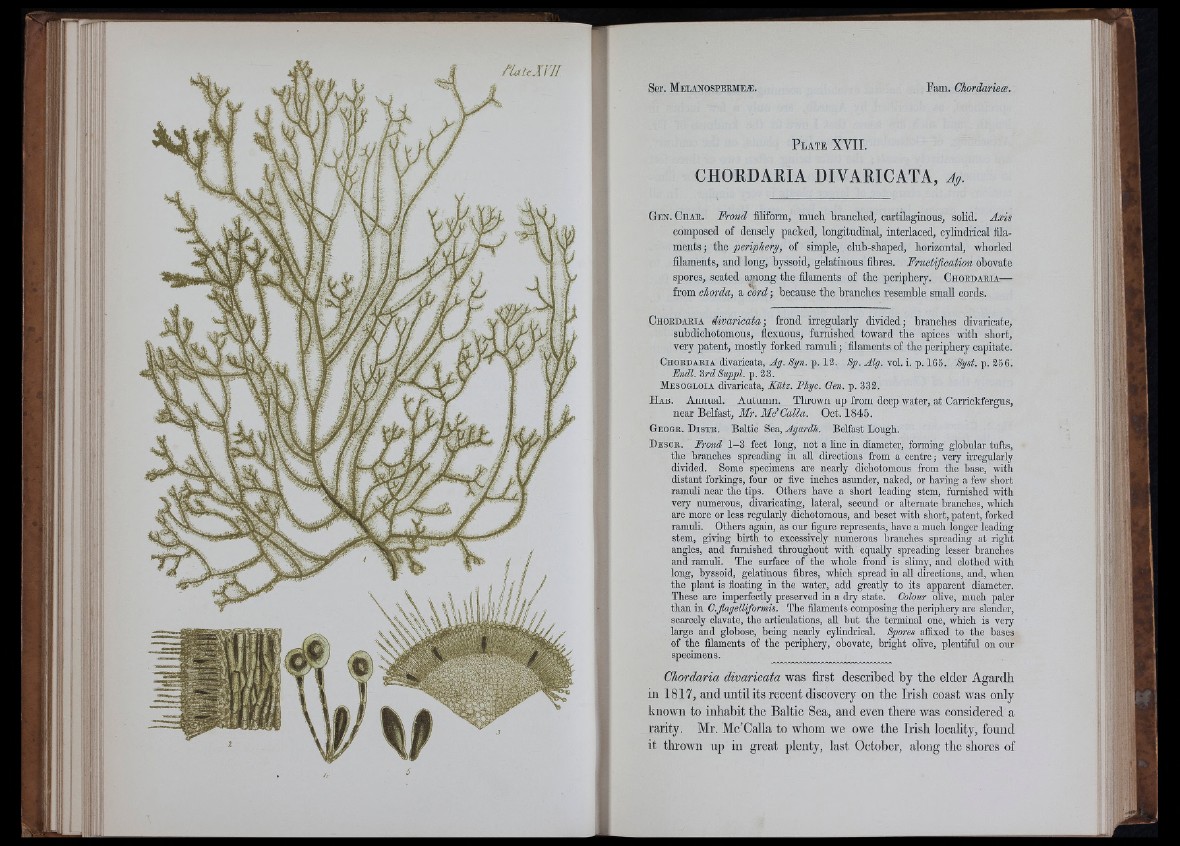
n a K .x v n
n
P la t e XVII.
CHORDARIA DIVARICATA, A g .
Gen. Char. Frond flFform, much branched, cartilaginous, solid.
composed of densely packed, longitudinal, interlaced, cyhndrioal filaments
; the periphery, of simple, club-shaped, horizontal, whorled
filaments, and long, byssoid, gelatinous fibres. Fructification obovate
spores, seated among the filaments of the periphery. Chordaria—
from chorda, a cord-, because the branches resemble small cords.
Chordaria divaricata-, frond irregularly divided; branches divaricate,
subdichotomous, flexuous, furnished toward the apices with short,
very patent, mostly forked ramuli; filaments of the periphery capitate.
Chordaria divaricata, Ag. Syn. p. 13. Sp. Alg. vol. i. p. 165. Syst. p. 256.
Jikdl. 3rd Suppl. p. 33.
Mesogloia divaricata, Kiitz. Phyc. Gen. p. 333.
H ab. Annual. Autumn. Thrown up from deep water, at Carrickfergus,
near Belfast, Mr. Me’Calla. Oct. 1846.
Geogr. Dis tr . Baltic Sea, Agardh. Belfast Lough.
D escr. Frond 1-3 feet long, not a line in diameter, forming globular tufts,
the bi-anches spreading in all dhections from a centre; very u-regularly
divided. Some specimens are nearly dichotomous from the base, with
i I distant forkings, four or five inches asunder, naked, or having a few short
< \ ramuli near the tips. Others have a short leading stem, furnished with
very numerous, divaricating, lateral, seound or alternate branches, which
ai'e more or less reg-ularly dichotomous, and beset with short, patent, forked
ramidi. Others again, as our figure represents, have a much longer leading
stem, giving birth to excessively numerous branches spreading at right
angles, and furnished throughout with equally spreading lesser branches
and ramuli. The surface of the whole frond is slimy, and clothed with
long, byssoid, gelatinous fibres, which spread in aU directions, and, when
the plant is floating in the water, add gi'eatly to its apparent diameter.
These are imperfectly preserved in a dry state. Colour olive, much paler
than in C.fiagelliformis. The filaments composing the periphery are slender,
scarcely clavate, the articulations, all hut the terminal one, which is very
large and globose, being nearly cylindrical. Spores affixed to the bases
of the filaments of the periphery, obovate, bright oKve, plentiful on our
specimens.
Chordaria divaricata was first described by the elder Agardh
in 1817, and until its recent discovery on the Irish coast was only
known to inhabit the Baltic Sea, and even there was considered a
rarity. Mr. Mc’Calla to whom we owe the Irish locality, found
it thrown up in great jfienty, last October, along the shores of
iiL